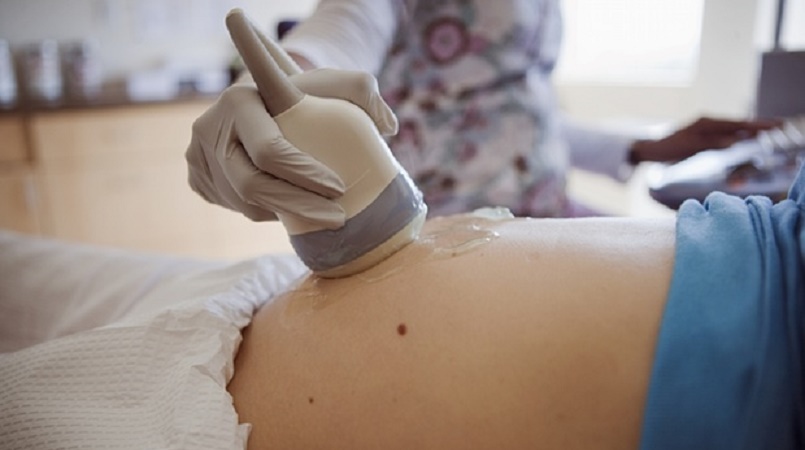
Doctors are being advised to wait longer before they diagnose a miscarriage in order to avoid the risk of ending a pregnancy that might have been viable.
Experts who have carried out a large study say the guidelines for hospitals on diagnosing a miscarriage need to be updated, so that women always get a second ultrasound scan two weeks after the first if the gestational sac seen in the scan is small. It is not always possible to be sure that a very small embryo with no detectable heartbeat is going to miscarry, they say.
A large study published in the BMJ Open journal looked at the outcomes for 2,845 women who arrived at NHS hospitals with bleeding or pain and had a scan that doctors felt showed the continuation of the pregnancy was uncertain. The researchers found that 19 pregnancies out of 549 would have wrongly been thought to have miscarried if the current guidelines had been followed and they had not been scanned two weeks later.
The guidelines from the National Institute for Health and Care Excellence (Nice) say that a second scan should be offered if the gestational sac is over 25mm in diameter. Many doctors will offer a second scan even for a smaller pregnancy. But the guidelines need to state that this must happen, said Tom Bourne, consultant gynaecologist at Queen Charlotte’s and Chelsea hospital, professor at Imperial College, and the lead author of the study. “When they are dealing with something as important as miscarriage, it has to be black and white,” he said.
The early weeks of pregnancy are an anxious time for women. About one in five pregnancies ends in miscarriage, most within the first three months. But establishing whether a miscarriage has taken place in the early weeks is difficult. It rests on the size of any embryo, if it can be seen, the size of the gestational sac and whether it appears empty, and whether a heartbeat can be detected during an ultrasound scan.
In 2011, as a result of work by the same team of experts, it was recognised that the guidelines that had existed were unsafe and that there was a risk that some viable pregnancies might have been ended. That led to the 2011 update. Broadly, the guidelines were now right, the team said, but they are not specific enough about the size of the embryo related to gestational age and should specify the 14-day wait between scans in most cases.
“Women should be able to rely on a diagnosis of miscarriage. It’s an area of medicine where the highest levels of caution are warranted,” said Bourne. “Just one misdiagnosis of miscarriage is too many. We have shown that perhaps people are being brought back too early. Most guidelines say if you’re uncertain, then come back in seven days, repeat the scan, and at that time you should expect to see a heartbeat or, perhaps if you have an empty sac, you should expect to see an embryo.
“Our data says that if you do that, you are possibly going to have a false positive diagnosis in a small number of cases. We are talking about a small number of cases, but remember there should be no errors over something as important as this. What we are saying is, in most cases, you simply wait a little bit longer, perhaps 14 days. If you do that, then the chance of a false positive is just not there – it’s zero per cent.”
Parents would inevitably be anxious and afraid while waiting for the second scan. “We understand entirely. There is a trade-off. Uncertainty is a terrible thing for people to have,” he said. But “most people would want absolute certainty”.
If a miscarriage is diagnosed, there are three options: to wait for nature to take its course, surgery, or to take pills that will precipitate the expulsion of the foetus.
Dr Paul Fogarty, a consultant obstetrician and vice-president of the Royal College of Obstetricians and Gynaecologists, said the Nice guidelines had been carefully drafted to avoid misdiagnosis. He said: “Some women are already advised to wait up to 14 days after the first scan to confirm the diagnosis of miscarriage, particularly if there are doubts about gestational age. But the current evidence suggests a minimum of seven days is sufficient to ensure a correct diagnosis in the majority of cases.”
Fogarty said: “The time a woman may have to wait before knowing whether her pregnancy has miscarried can be very difficult and this was also considered during the development of these guidelines. It is essential that both the clinicians and the parents are 100% confident that the pregnancy is not viable before making a diagnosis of miscarriage. If there is any doubt, the scans will be repeated.”
In an editorial linked to the study, academics in Melbourne, Australia, wrote: “The diagnosis of a miscarriage will more than likely dash the hopes and dreams of couples anticipating the life-changing possibilities of a new addition to their family: a new house, extended leave from work, relief in finally appeasing grandparents-in-waiting. It is therefore paramount that clinicians get it right. Always.”
But in spite of the advances in ultrasound technology, said Elizabeth Anne McCarthy and Stephen Tong, “We cannot get around the fact that often we still must resort to watching and waiting.”
